New tree study for Bloomington measures canopy at 38 percent, climate strikers demand 60 percent
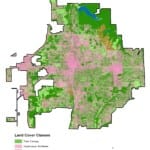
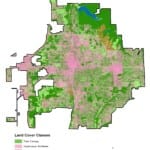
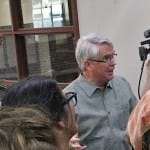
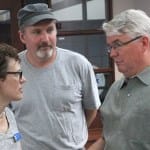
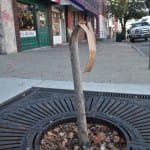
A key stat from a new tree inventory for the city of Bloomington, released on Tuesday, found its way into a list of climate activist demands presented to Mayor John Hamilton on Friday.
The demands were presented to the mayor a little after 3 p.m. by around 400 people who marched from Dunn Meadow, where Bloomington’s Climate Strike activities had started, to city hall. The third point on the list was:
Get the City of Bloomington to 60% Tree Coverage.
Based on a report delivered on Tuesday to Bloomington’s board of park commissioners by Aren Flint, an urban forester with Davey Resource Group (DRG), the maximum tree canopy that Bloomington could achieve is 61 percent of its 15,000 acres. So the demand is essentially to max out Bloomington’s potential canopy. (The layer of leaves, branches and trunks of trees that block the view of the ground from above is called the “canopy.”)
The climate strikers’ demand noted that Bloomington’s tree canopy now covers just 38 percent of Bloomington’s area. That’s the figure from Tuesday’s new report, which is a 2018 analysis.
Canopy Stats
The canopy statistic presented in DRG’s report was down two points from the 40 percent reported in a 2008 study. Flint pointed out that it was down just one point from 10 years earlier in 1998.
The graph she displayed showed a projection of a 33-percent canopy by 2048, if the two-point drop over the last 10 years continues as a trend. Measurements of tree canopy take all land into consideration, not just the places where public trees can grow.
Public Trees: Counts and Species
Public trees were the focus of the city’s press release announcing the results of the DRG study—they provided some positive highlights for the report. Those included a 56-percent increase in the number of public trees in the 12 years since the last inventory. The 2019 inventory records 19,013 public trees, up from the 2007 count of 12,169, which was already more than the 10,522 public trees counted in 1994.
DRG’s Aren Flint highlighted in her presentation a point about stocking levels. Of the spots where street trees could be growing in Bloomington, 77 percent of them have a tree, compared to an Indiana statewide average of 52 percent.
The increased diversity of the public tree population was a point highlighted by the city’s press release and by DRG’s presentation. Flint presented a slide showing how some specific tree types stack up against a general rule of thumb that no one species should represent more than 10 percent of the total tree population—too many of one tree type can make the urban forest vulnerable to any disease or pest that thrives on that particular type. Examples of that include Dutch elm disease and emerald ash borer.
Since 1994, the sugar and silver maple populations dropped from 11 percent for each of them to 6 and 3 percent, respectively. On the other hand, red maples have increased from around 10 percent to 13 percent, 3 points higher than the general guideline.
Public Trees: Health
The relative health of public trees shows a positive trend, according to the DRG report. In 1994, according to the DRG presentation to the board of park commissioners, 87 percent of public trees were assessed as in good or fair condition. The digits appear to have been transposed in the figure—the 1994 report says 78.6 percent of trees were in good or fair condition.
Compared to 78.6 percent in 1994, this year’s inventory is 13 points better—92 percent of trees are good (8,022) or fair (9,552) condition. The 92-percent figure for this year is about the same as the 92.4 percent of street trees that were rated in good or fair condition by the 2007 study.
On Tuesday, the breakdown of trees in good-versus-fair condition was not presented for previous years. The percent of trees in good condition this year works out to 42 percent. A focus just on trees that were rated in good condition, leaving out those in fair condition, shows a negative trend.

The 2007 report gives health condition stats for the 20 most populous species of trees: 65.4 percent of them were rated in good condition and 27.1 percent were in fair condition. Compared to 2007, the percentage of trees in good condition this year showed a 20-point drop.
Climate Connection
Why do climate strikers want more trees? It’s due to the climate-related benefits that trees offer. The benefits offered by Bloomington’s public trees can dowloaded from one of the online tools that DRG delivered to the city as a part of its $125,250 contract.
According to TreeKeeper, the largest diameter single-stem public tree in Bloomington is a 5-foot-4-inch diameter American sycamore (Platanus occidentalis) near the intersection of Wylie and Henderson streets.
And according to TreeKeeper, that sycamore tree provides the following benefits:
| GHG Benefits: $0.42 | H2O Benefits $42.23 | Energy Benefits $17.03 | Air Benefits $4.84 |
| 306.47 lbs CO2 avoided | 6,810.83 gallons saved | 171.11 kWh saved
5.55 Therms saved |
3.24 lbs pollutants saved |
One of the sub-demands of the climate strikers is that half of the new trees added to the city, to get the canopy up to 60 percent, should be food-bearing. The data available in TreeKeeper makes it easy to find food-bearing trees that are already a part of the city’s urban forest. Here’s a map The Beacon built showing where all the public persimmon trees are growing:
TreeKeeper: Priority Planting
Included in the TreeKeeper map layers are color-coded regions of the city prioritized for planting of trees. Red areas are high priority. Magenta areas are low priority areas. While species identification, health assessment and diameter measurement was done on the ground, the landcover analysis was done by DRG using aerial imagery.
At least a few of the specific areas identified as high priority for planting already have some trees, based on a site visit from The Beacon. The medians in the parking lot next to the Indiana football stadium have some trees planted, and they’ve been there since at least 2015, based on Google StreetMaps images. The priority assigned to the area might be an oversight, or reflect a recommendation to plant additional trees, between those that have already been planted.

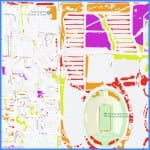
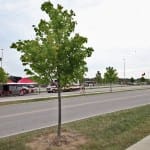
TreeKeeper does not show planting areas of any priority for Cascades Golf Course. During her presentation on Tuesday, DRG’s Aren Flint said that areas that have land uses that are not consistent with planting trees were excluded from the analysis.
During the city council’s departmental budget hearings held in August, the idea of planting trees or a prairie on the golf courses, instead of offering golf services, got mentioned by a couple of councilmembers—Dave Rollo and Isabel Piedmont-Smith
Piedmont-Smith and Rollo were among the climate strikers who addressed Mayor John Hamilton on Friday. After the crowd filtered away, the two talked with mayor on climate-related issues.
Both councilmembers said during the budget hearings that they’re keen to see the mayor appoint a director-level city position to manage the city’s response to climate change—it’s similar to one of the demands that was presented on Tuesday. Such a position has not been added as a part of the minor revisions to the budget released on Friday, set for its first hearing in front of the city council on Sept. 25.
TreeKeeper: What kind of tree is it?
The TreeKeeper data also provides residents an easy way to answer the most basic question about trees they see around town: What kind of tree is this? TreeKeeper makes it possible to identify a tree that’s no longer even there.


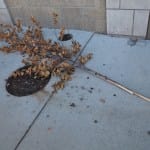
What’s now left of a tree on the east side of Walnut between 6th and 7th streets is maybe three feet of its trunk. The 2-inch diameter could not withstand whatever force it was put under, and it broke off. But it can be identified though TreeKeeper as a littleleaf linden.
Breaking off a whole tree appears to violate the city’s street tree ordinance , passed in 2008, which says you can’t “damage, cut, carve or deface” a street tree. Responding to a question from The Beacon, assistant city attorney Barbara McKinney said that someone who damaged a tree to the extent of the one on Walnut street would probably be prosecuted criminally instead of under the street tree ordinance. Assuming the tree was worth at least $750, she said, the person could be charged with a Class A misdemeanor, with a penalty upon conviction of up to 365 days in jail and a fine up to $5,000.
The city’s urban forester, Lee Huss, told The Beacon that about 10 public trees are lost a year at a cost of around $5,000. Unless a police report is made, the city can’t prosecute, he said.
About the tree on Walnut, Huss said he’d already noticed it. “I have a work order to cut the tree flush with the tree grate and place wood chip to prevent tripping. We do happen to have the same tree that was planted in stock and will make arrangements for it to be planted this fall.”
Bloomington’s Urban Forester: 37 years of service
Huss probably won’t be the city’s forester by the time that tree gets replaced. He’s retiring in a couple of weeks, after 37 years of service to the city of Bloomington. He was hired as urban forester in September 1983 by then-mayor Tomilea Allison.
At Tuesday’s meeting of the park advisory commission, Dave Williams, operations director for Bloomington parks, described some of what Huss has accomplished over nearly four decades, including the achievement of Tree City USA status—Bloomington was the first community in Indiana to reach that goal.
Williams said he likes to kid Huss about being the only employee for the city who has a one-word job description: “trees.”





Comments ()